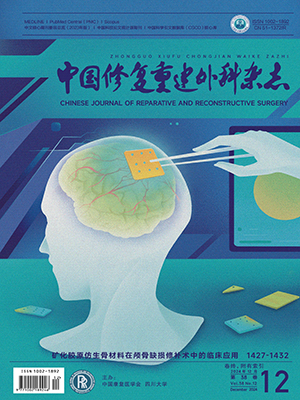Objective To investigate the effect of the vascular endothelial growth factor (VEGF) gene therapy, the surgical delay, and the combination of the two therapeutic approaches on the survival of the rat over-area abdominal axial skin flap. Methods In 48 male Wistar rats (weight, 400-450 g), a model of the abdominal axial skin flap supplied by the superficial epigastric blood vessel was created. The rats were randomly divided into 6 groups: Group A (the blank group), Group B (the gene-therapy-during-operation group), Group C (the gene-therapy-before-operation group), Group D (themerely-surgical-delay group), Group E (the gene-therapy-during-surgical-delay group), and Group F (the gene-therapy-aftersurgical-delay group). Seven days after operation, the survival rate of the skin flap was measured; the specimens were harvested from the skin flap for a histological investigation of themicrovessels and for an immunohistochemical staining to observe the expression of VEGF165. Results The average survival rate of the skinflap was significantly greater in each of the treated groups than in Group A (P lt;0.05); the rate was the greater in Group E (P lt;0.05), but with no statistically significant difference between the other treated groups (P gt;0.05). The average number of the microvessels was significantly greater in Groups B, C, E andF than in Groups A and D (P lt;0.05), but with no statistically significant difference between Groups B, C, E and F and between Groups A and D (P gt;0.05). The lumen diameter of the microvessels was significantly greater in Group D than in Groups E and F (P lt;0.05), and the diameter was significantly greater in Groups D, E andF than in the other groups (P lt;0.05). More deposition of VEGF DNA detected by the immunohistochemical staining was in Groups B, C, E and F than in Groups A and D. There was no newly-formed blood vessel in the rat cornea in the treated groups.Conclusion Both the administration of pcDNA4-VEGF165 and the surgical delay can improve the survival of the rat abdominal axial skin flap, but the mechanism of the effect is different in explanation. The combination of the two therapeutic approaches can achieve a better effect.
Citation: ZHANG Yan,MAO Junsheng,WANG Bingchen,et al.. SURVIVAL OF RAT OVERAREA ABDOMINAL AXIAL SKIN FLAP AFTER APPLICATION OF VASCULAR ENDOTHELIAL GROWTH FACTOR GENE AND SURGICAL DELAY. Chinese Journal of Reparative and Reconstructive Surgery, 2007, 21(6): 625-628. doi: Copy
Copyright © the editorial department of Chinese Journal of Reparative and Reconstructive Surgery of West China Medical Publisher. All rights reserved




